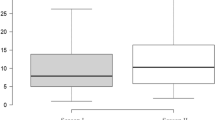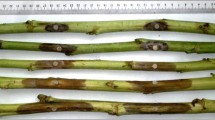Summary
Twenty sunflower inbred lines were studied for their reactions to 7 Sclerotinia sclerotiorum tests on different plant parts. A principal component analysis (P.C.A.) and t-tests on the means of resistant and susceptible groups indicated that reactions of inbred lines to infection of capitula by ascospores are independent from those to ascospore infections of terminal buds. They are even more contrasted with the results of any test measuring mycelial extension. However, for the last, there is a close association between the reactions of roots, leaves and capitula. Of the inbred lines, some showed good levels of resistance to most forms of attack, others were generally susceptible and there were some with good resistance to one particular form of attack. A P.C.A. of 18 morphological and field characters showed no general association between these characters and Sclerotinia sclerotiorum test results, although it was found that lines resistant to mycelial extension on capitula were generally earlier than those that were more susceptible. It is proposed that breeding programmes for general resistance to Sclerotinia sclerotiorum should include a combination of two or three tests.
Similar content being viewed by others
References
Bazzalo M., P.Dimarco, F.Martínez & G.Daleo, 1991. Indicators of resistance of sunflower plant to basal stalk rot (Sclerotinia sclerotiorum): symptomatological, biochemical, anatomical and morphological characters of the host. Euphytica 57: 195–205.
Castaño R., F.Vear & D.Tourvieille, 1989. L'utilisation de plusieurs tests simultanés dans la sélection pour la résistance du tournesol vis-à-vis de Sclerotinia sclerotiorum. Inf. Tech. Cetiom 107: 14–20.
Castaño F., M.C.Hémery-Tardin, D. TourvieilledeLabrouhe & F.Vear, 1992. The inheritance and biochemistry of resistance to Sclerotinia sclerotiorum leaf infections in sunflower (Helianthus annuus L.). Euphytica 58: 209–219.
Gulya, T., 1985. Evaluation of sunflower germplasm for resistance to Sclerotinia stalk rot and race 3 Downy Mildew. In: Proceedings, 11th International Sunflower Conference, 10–13/03/85, Mar del Plata, Argentina, II: 349–352.
Hémery-Tardin, M.C., 1992. Recherche de marqueurs biochimiques de la résistance du tournesol à Sclerotinia spp. Doctoral Thesis, Blaise Pascal Univ., Clermont Fd., France, 106 p.
Kesteloot, J., P. Leclercq & H. Serieys, 1978. Recherches contribuant à la détermination des éléments permettant la différentiation entre hybrides à haut et bas rendement dans le tournesol (Helianthus annuus). In: Proceedings, 8th International Sunflower Conference, 23–27/07/78, Minneapolis, USA, 343–347.
Lebart L. & J.Fenelon, 1973. Statistique et informatique appliquées. 2nd Ed., Dunod, Paris, France, 457 p.
Noyes R. & J.Hancock, 1981. Role of oxalic acid in Sclerotinia wilt of sunflower. Physiol. Plant Pathol. 18: 123–132.
Péres, J. & Y. Regnault, 1985. Sclerotinia sclerotiorum (Lib.) de Bary: Recherche de moyens chimiques permettant de limiter la production d'inoculum par traitement du sol. In: Proceedings, 11th International Sunflower Conference, 10–13/03/82, Mar del Plata, Argentina, II: 363–368.
Philippeau G., 1986. Comment interpréter les résultats d'une analyse en composantes principales? (Ed.) ITCF, Paris, France, 63 p.
Pirvu N., A.Vranceanu & F.Stoenescu, 1985. Genetic mechanisms of sunflower resistance to white rot (Sclerotinia sclerotiorum Lin. de By.). Z. Pflanzenzüchtg. 95: 157–163.
Robert N., F.Vear & D.Tourvieille, 1987. L'hérédité de la résistance au Sclerotinia sclerotiorum (Lib.) de Bary chez le tournesol. I. Etude des réactions à deux tests mycéliens. Agronomie 7: 423–429.
Thuault M. & D.Tourvieille, 1988. Etude du pouvoir pathogène de huit isolats de Sclerotinia appartenant aux espèces Sclerotinia sclerotiorum, Sclerotinia minor et Sclerotinia trifoliorum sur tournesol. Inf. Tech. Cetiom 103: 21–27.
Tourvieille D. & F.Vear, 1984. Comparaison de méthodes d'estimation de la résistance au Sclerotinia sclerotiorum (Lin.) de Bary. Agronomie 4: 517–525.
Tourvielle D. & F.Vear, 1990. Heredity of resistance to Sclerotinia sclerotiorum in sunflowers. III. Study of reactions to artificial infections of roots and cotyledons. Agronomie, 10: 323–330.
Tourvieille, D., F. Vear & El H. Achbani, 1992. Attack of sunflower terminal buds by Sclerotinia sclerotiorum symptoms and resistance. In: Proceedings, 13th International Sunflower Conference, 8–10/09/92, Pisa, Italy, 859–864.
Vear F. & D.Tourvieille, 1988. Heredity of resistance to Sclerotinia sclerotiorum in sunflowers. II. Study of capitulum resistance to natural and artificial ascospore infections. Agronomie 8: 503–508.
Vear F. & J.Guillaumin, 1977. Etude des méthodes d'inoculation du tournesol par Sclerotinia sclerotiorum et application à la sélection. Ann. Amél. Plantes 27: 523–527.
Zimmer, D. & J. Hoes, 1978. Diseases. In: J. Carter (Ed.) Sunflower Science and Technology, Am. Soc. of Agron., Agronomy 19, Madison, USA, 225–262.
Author information
Authors and Affiliations
Rights and permissions
About this article
Cite this article
Castaño, F., Vear, F. & de Labrouhe, D.T. Resistance of sunflower inbred lines to various forms of attack by Sclerotinia sclerotiorum and relations with some morphological characters. Euphytica 68, 85–98 (1993). https://doi.org/10.1007/BF00024158
Received:
Accepted:
Issue Date:
DOI: https://doi.org/10.1007/BF00024158




